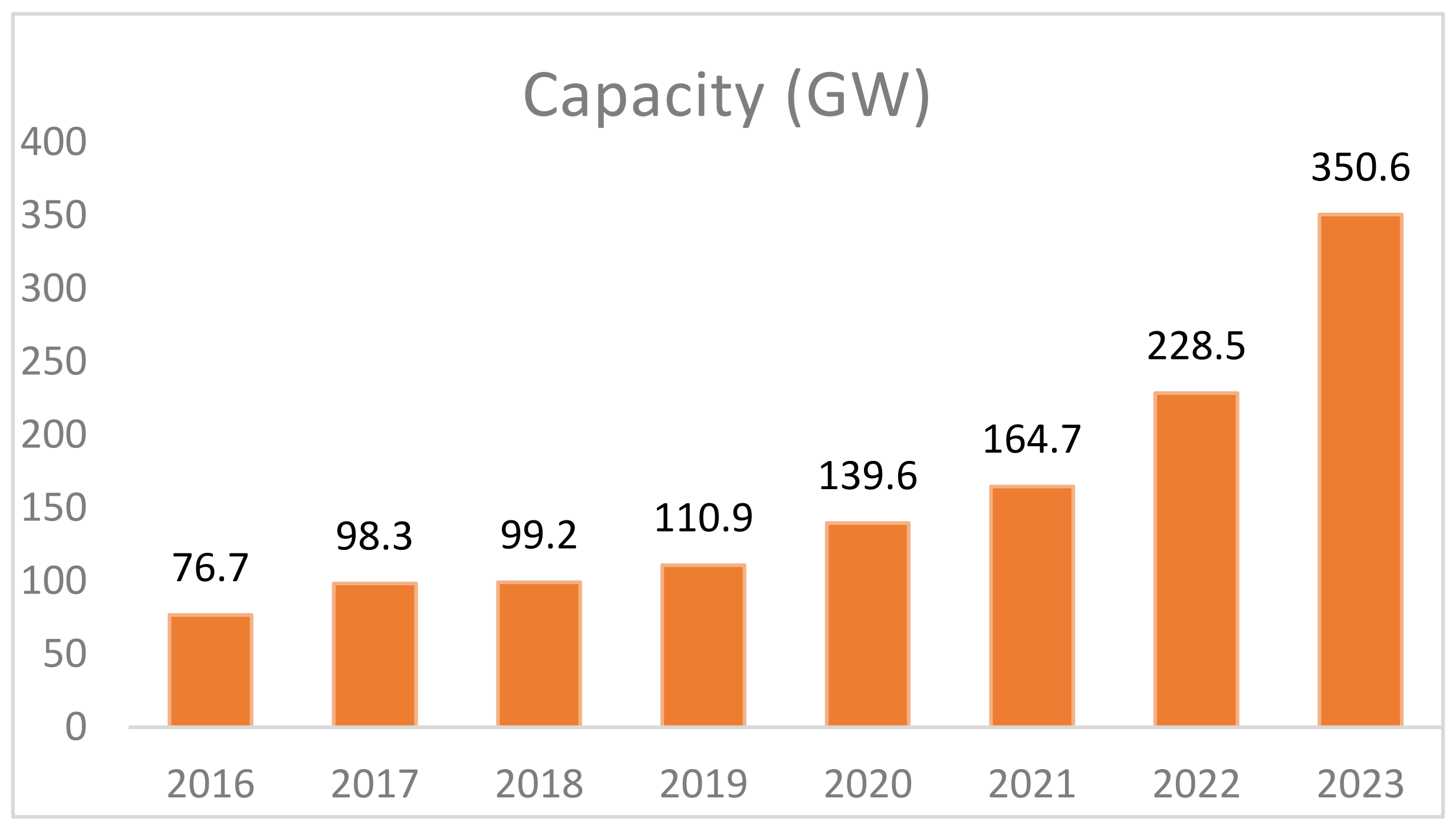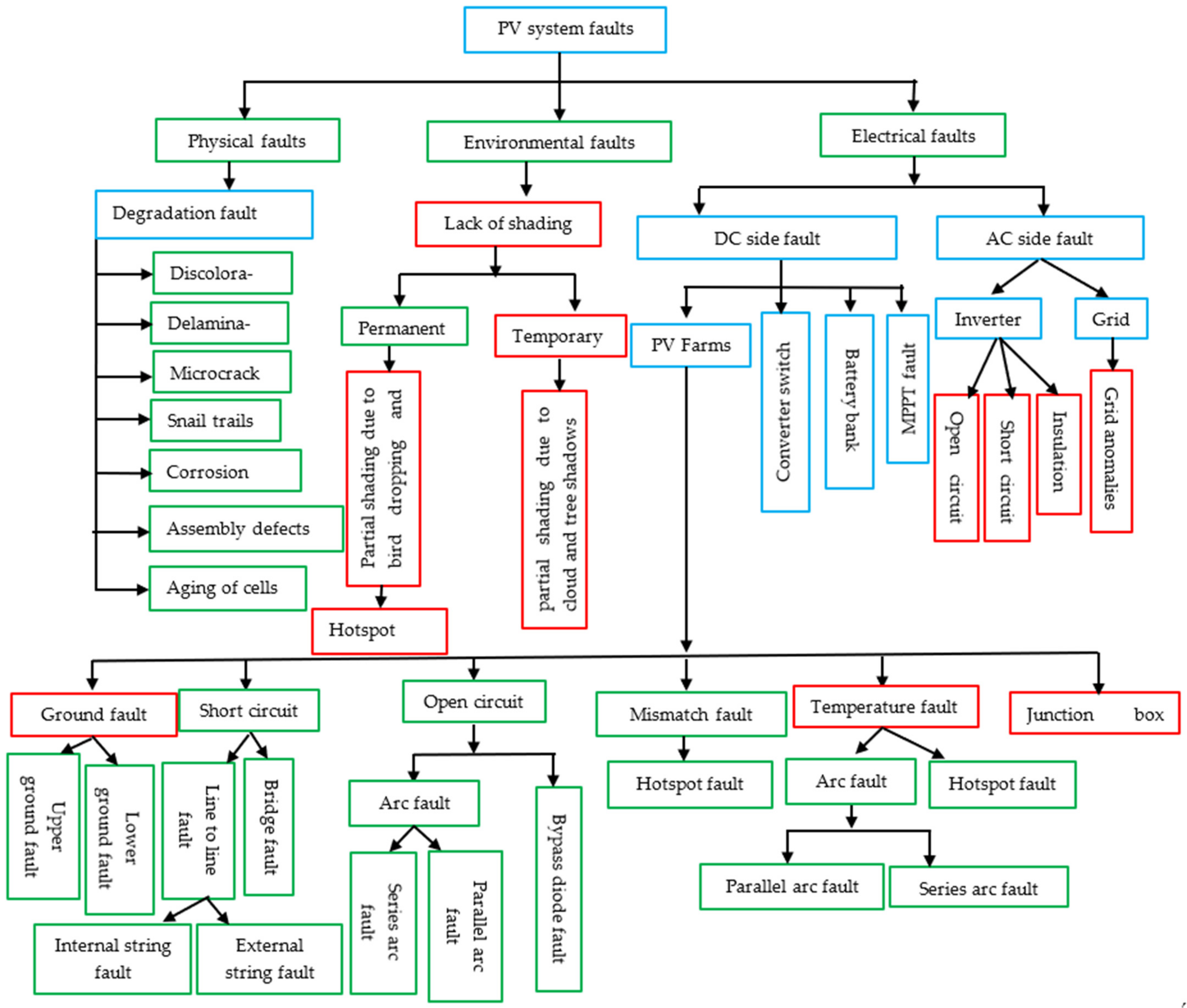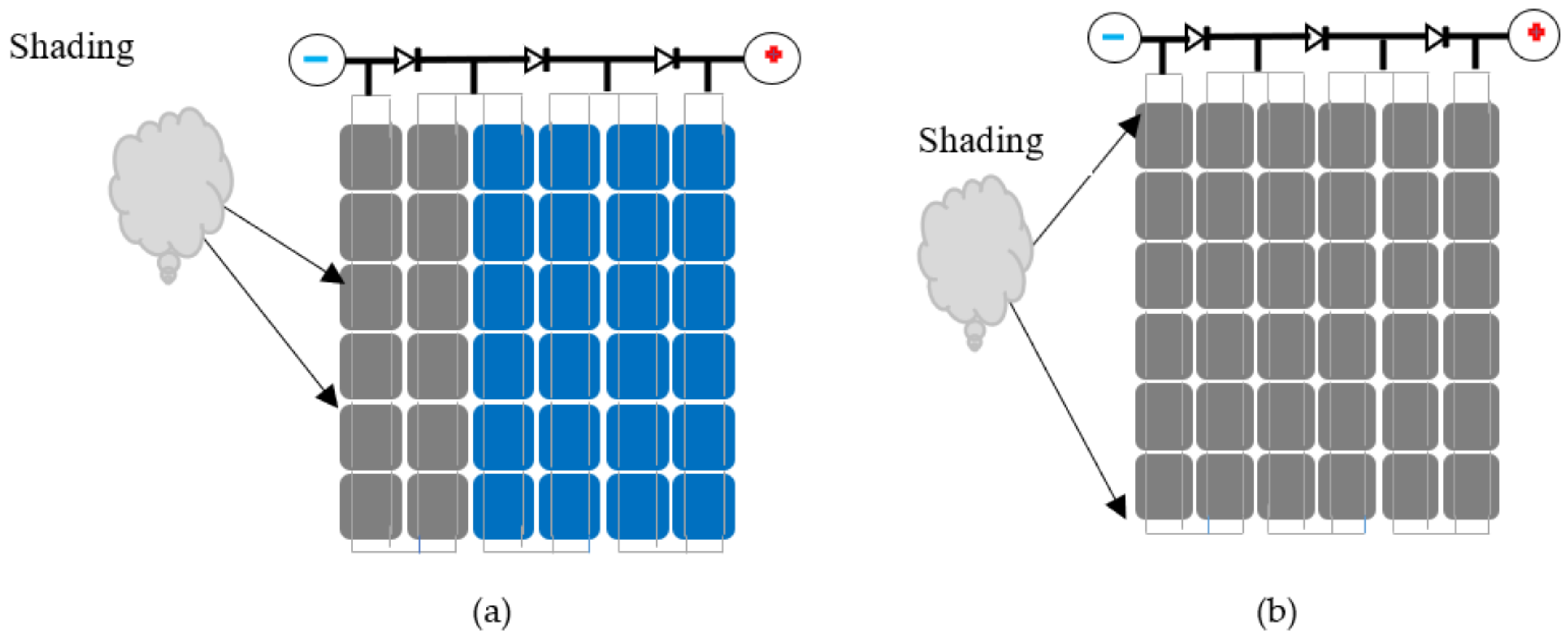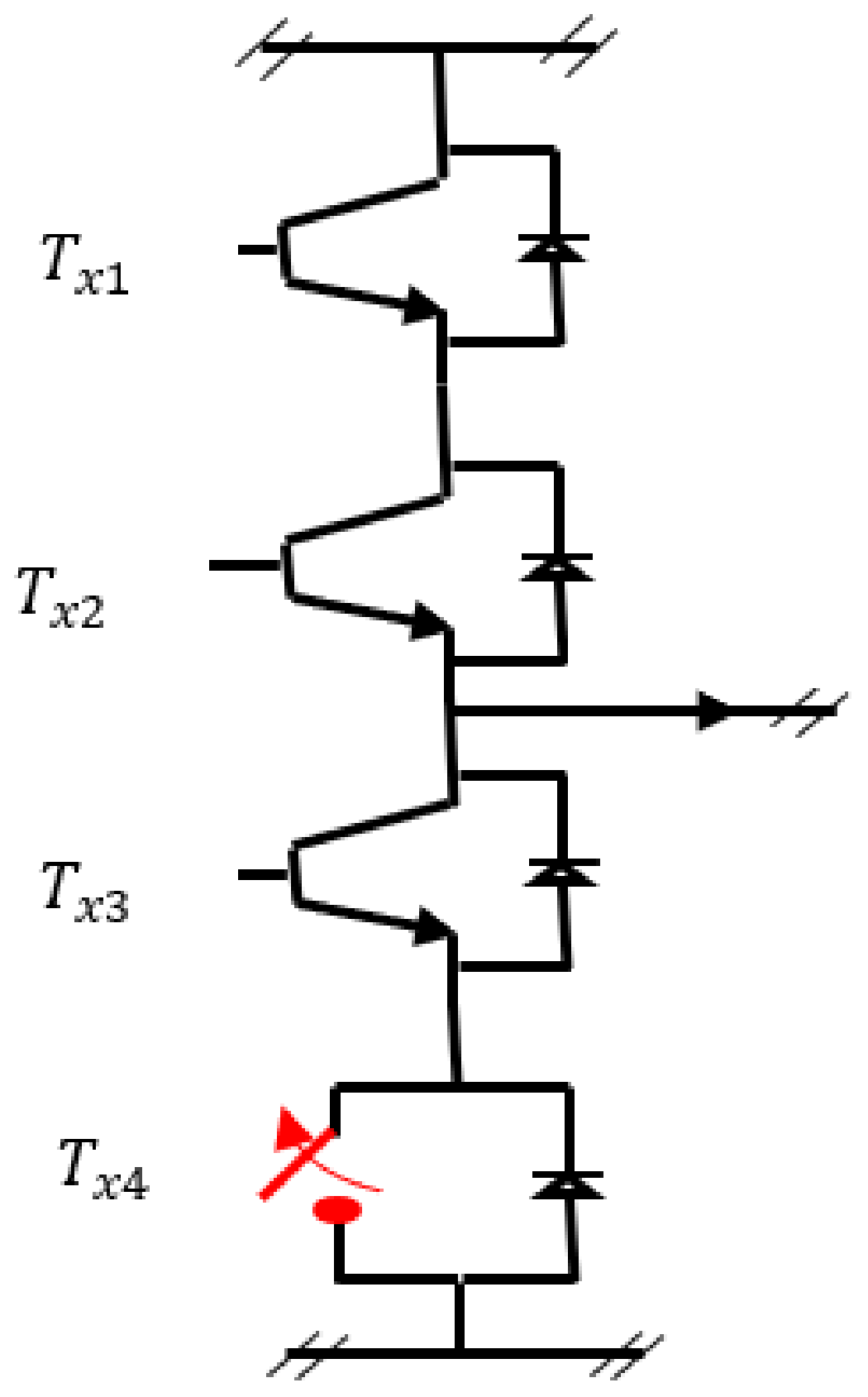
| Version | Summary | Created by | Modification | Content Size | Created at | Operation |
|---|---|---|---|---|---|---|
| 1 | TOCHE TCHIO Guy Merlin | -- | 2600 | 2024-03-11 10:08:16 | | | |
| 2 | Peter Tang | Meta information modification | 2600 | 2024-03-11 10:13:26 | | | | |
| 3 | Peter Tang | Meta information modification | 2600 | 2024-03-15 08:56:39 | | |
Video Upload Options
Photovoltaic systems are prone to breaking down due to harsh conditions. In photovoltaic systems, various types of faults can cause power loss in some way. To improve the reliability of these systems, diagnostic methods using Machine Learning (ML) have been developed.
1. Introduction


2. Photovoltaic Generator Faults
2.1. Ground Fault
2.2. Short-Circuit Fault (SCF)
2.3. Line to Line Fault

2.4. Open-Circuit Fault (OCF)
2.5. Arc Fault
2.6. Mismatch/Shading Defects


3. PV Inverter Faults (PVI)
3.1. Short-Circuit Fault
3.2. Open-Circuit Fault

|
Type of Defects |
Causes |
Effects |
Consequences |
||
|---|---|---|---|---|---|
|
Internal |
Short circuit |
Manufacturing defect |
Low impedance, blocked path between internal power rails |
Reduction of power produced |
|
|
Cell microcracks |
Manufacturing defect |
Difference in module characteristics |
Unable to deliver power to the load |
||
|
Broken modules |
Shock during transport |
||||
|
Degraded modules |
Aging |
Drop in power delivered |
Low production |
||
|
Bypass diode |
Manufacturing defect, wiring defect |
Can’t drive |
Unable to prevent the appearance of hot spots, electric arc, fire risk |
||
|
Open circuit |
Manufacturing defect, wiring defect |
Lack of access path for the power produced |
No power produced |
||
|
External |
Mismatch fault |
Temporary |
Temporary shading |
Cloud |
Drop in production, risk of fires |
|
Permanent |
Equipment damage |
Blackout |
No production |
||
|
Shading |
Temporary |
Passage of clouds, weather conditions |
Uneven distribution of irradiation on the surface of the modules |
Drop in power produced |
|
|
Natural disaster |
Module reverse bias |
Hot spot/fire hazard |
|||
|
Permanent |
Partial shading |
||||
|
PV field |
Short circuit |
Bad wiring between inverter and PV field, chewing of cables by animals, water infiltration into modules |
Drop in network voltage and increase in current |
Drop in production |
|
|
Open circuit |
Accidental breakage of connecting cables |
Drastic drop in short-circuit current |
Drop in production |
||
|
Line to line |
Faulty connection link between the different rail circuits |
Power loss |
Reduction of open circuit voltage, modification of characteristic IV of the PV field |
||
|
Arc fault |
Accidental passage of current in a dielectric |
Strong noise in currents and voltages |
Fire hazard |
||
|
Line to ground |
Ground wiring fault, corrosion |
Drop in network voltage and increase in current |
Risk of electrocution, variable voltage |
||
|
PV inverter |
Inverter open circuit |
Absence of gate control, connection wire breakage due to high short-circuit current, external disconnection due to vibrations |
Deterioration of phase current and torque |
External radiation |
|
|
Inverter short circuit |
High gate voltage, delamination and cracking in the solder layer, static locking and high temperature |
Excessive leakage current, affected phase current close to zero |
Temperature variation |
||
|
Insulation fault |
Humidity, high heat, poor connection in the solar panel junction box, aging of solar panels |
No power |
|||
|
Grid |
Grid anomalies |
Electrical overload, deterioration of conductive insulators |
Network disruption, voltage dips and peaks, harmonics |
Interruption of current flow, short circuit |
|
References
- TrendForce. Global Solar Installation May Hit 350.6 GW. Available online: https://www.pv-magazine.com/2023/03/09/pv-product-prices-resume-downward-trend-says-trendforce/ (accessed on 25 April 2023).
- Livera, A.; Theristis, M.; Makrides, G.; Georghiou, G.E. Recent advances in failure diagnosis techniques based on performance data analysis for grid-connected photovoltaic systems. Renew. Energy 2019, 133, 126–143.
- Madeti, S.R.; Singh, S.N. Modeling of PV system based on experimental data for fault detection using kNN method. Sol. Energy 2018, 173, 139–151.
- Oh, W.-G. A Fault Detection Scheme in Acoustic Sensor Systems Using Multiple Acoustic Sensors. J. Korea Inst. Electron. Commun. Sci. 2016, 11, 203–208.
- Abubakar, A.; Almeida, C.F.M.; Gemignani, M. Review of artificial intelligence-based failure detection and diagnosis methods for solar photovoltaic systems. Machines 2021, 9, 328.
- Jiang, Y.; Yin, S.; Kaynak, O. Optimized design of parity relation-based residual generator for fault detection: Data-driven approaches. IEEE Trans. Industr. Inform. 2021, 17, 1449–1458.
- Mohammad, S.; Sudhakar, K. Machine Learning-Autonomous Vehicles. Int. J. Manag. 2018, 8. Available online: http://www.ijmra.us (accessed on 29 December 2023).
- Livera, A.; Theristis, M.; Makrides, G.; Georghiou, G.E.; Sutterlueti, J.; Georghiou, G.E. Advanced Diagnostic Approach of Failures for Grid-Connected Photovoltaic (PV) Systems PV-Estia-Enhancing Storage Integration in Buildings with Photovoltaics View Project Modeling and Optimization of Advanced Energy Systems View Project Advanced Diagnostic Approach of Failures for Grid-Connected Photovoltaic (PV) Systems. 2018. Available online: https://userarea.eupvsec.org/proceedings/35th-EU-PVSEC-2018/6BO.6.5/ (accessed on 8 May 2023).
- Karatepe, E.; Syafaruddin; Hiyama, T. Controlling of artificial neural network for fault diagnosis of photovoltaic array. In Proceedings of the 16th International Conference on Intelligent System Applications to Power Systems, Hersonissos, Greece, 25–28 September 2011; pp. 1–6.
- Bendary, A.F.; Abdelaziz, A.Y.; Ismail, M.M.; Mahmoud, K.; Lehtonen, M.; Darwish, M.M.F. Proposed anfis based approach for fault tracking, detection, clearing and rearrangement for photovoltaic system. Sensors 2021, 21, 2269.
- Soffiah, K.; Manoharan, P.S.; Deepamangai, P. Fault detection in grid connected pv system using artificial neural network. In Proceedings of the 7th International Conference on Electrical Energy Systems, ICEES, Chennai, India, 11–13 February 2021; pp. 420–424.
- Gong, S.; Wu, X.; Zhang, Z. Fault diagnosis method of photovoltaic array based on random forest algorithm. In Proceedings of the 2020 39th Chinese Control Conference (CCC), Shenyang, China, 27–29 July 2020; pp. 4249–4425.
- Hussain, M.; Dhimish, M.; Titarenko, S.; Mather, P. Artificial neural network based photovoltaic fault detection algorithm integrating two bi-directional input parameters. Renew. Energy 2020, 155, 1272–1292.
- Alimi, O.A.; Meyer, E.L.; Olayiwola, O.I. Solar photovoltaic modules’ performance reliability and degradation analysis: A review. Energies 2022, 15, 5964.
- Romero, H.F.M.; Rebollo, M.G.; Cardeñoso-Payo, V.; Gómez, V.A.; Plaza, A.R.; Moyo, R.T.; Hernández-Callejo, L. Applications of artificial intelligence to photovoltaic systems: A review. Appl. Sci. 2022, 12, 56.
- Xie, C.; Chen, S.; Guo, F.; Liu, X. A deep residual recurrent neural network model-augmented attention with physical characteristics: Application to turntable servo system. IEEE Trans. Ind. Electron. 2022, 69, 489.
- Yau, H.T.; Prior, S.D.; Wang, Y.; Li, Y. IEEE Access Special Section Editorial: Advanced artificial intelligence technologies for smart manufacturing. IEEE Access 2021, 9, 119232–119234.
- Fei, Z.; Zhang, Z.; Tsui, K.L. Deep learning powered online battery health estimation considering multi-timescale ageing dynamics and partial charging information. IEEE Trans. Transp. Electrif. 2023.
- Amiri, A.F.; Kichou, S.; Oudira, H.; Chouder, A.; Silvestre, S. Fault detection and diagnosis of a photovoltaic system based on deep learning using the combination of a convolutional neural network (cnn) and bidirectional gated recurrent unit (Bi-GRU). Sustainability 2024, 16, 1012.
- Rocha, H.R.O.; Fiorotti, R.; Fardin, J.F.; Garcia-Pereira, H.; Bouvier, Y.E.; Rodríguez-Lorente, A.; Yahyaoui, I. Application of AI for short-term pv generation forecast. Sensors 2023, 24, 85.
- Li, B.; Delpha, C.; Diallo, D.; Migan-Dubois, A. Application of artificial neural networks to photovoltaic fault detection and diagnosis: A review. Renew. Sustain. Energy Rev. 2021, 138, 110512.
- Berghout, T.; Benbouzid, M.; Bentrcia, T.; Ma, X.; Djurović, S.; Mouss, L.H. Machine learning-based condition monitoring for pv systems: State of the art and future prospects. Energies 2021, 14, 6316.
- Al Smadi, T.; Handam, A.; Gaeid, K.S.; Al-Smadi, A.; Al-Husban, Y.; Khalid, A.S. Artificial intelligent control of energy management PV system. Results Control. Optim. 2024, 14, 100343.
- Boubaker, S.; Kamel, S.; Ghazouani, N.; Mellit, A. Assessment of Machine and Deep Learning Approaches for Fault Diagnosis in Photovoltaic Systems Using Infrared Thermography. Remote Sens. 2023, 15, 1686.
- Mansouri, M.; Trabelsi, M.; Nounou, H.; Nounou, M. Deep learning-based fault diagnosis of photovoltaic systems: A comprehensive review and enhancement prospects. IEEE Access 2021, 9, 126286–126306.
- Kuo, W.C.; Chen, C.H.; Hua, S.H.; Wang, C.C. Assessment of different deep learning methods of power generation forecasting for solar pv system. Appl. Sci. 2022, 12, 7529.
- Hichri, A.; Hajji, M.; Mansouri, M.; Nounou, H.; Bouzrara, K. Supervised machine learning-based salp swarm algorithm for fault diagnosis of photovoltaic systems. J. Eng. Appl. Sci. 2024, 71, 12.
- Vai, V.; Chhorn, S.; Chhim, R.; Tep, S.; Bun, L. Modeling and Simulation of PV Module for Estimating Energy Production under Uncertainties. In Proceedings of the 2020 8th International Electrical Engineering Congress, IEECON 2020, Chiang Mai, Thailand, 4–6 March 2020.
- Arani, M.S.; Hejazi, M.A. The comprehensive study of electrical faults in PV arrays. J. Electr. Comput. Eng. 2016, 2016, 8712960.
- Pillai, D.S.; Rajasekar, N. A comprehensive review on protection challenges and fault diagnosis in PV systems. Renew. Sustain. Energy Rev. 2018, 91, 18–40.
- Aouchiche, N. Défauts Liés Aux Systèmes Photovoltaïques Autonomes et Techniques de Diagnostic-Etat de l’art. 2018. Available online: https://www.researchgate.net/publication/328577571 (accessed on 14 June 2023).
- Garoudja, E.; Chouder, A.; Kara, K.; Silvestre, S. An enhanced machine learning based approach for failures detection and diagnosis of PV systems. Energy Convers. Manag. 2017, 151, 496–513.
- Madeti, S.R.; Singh, S.N. A comprehensive study on different types of faults and detection techniques for solar photovoltaic system. Sol. Energy 2017, 158, 161–185.
- Trejo, D.R.E.; Bárcenas, E.; Díez, J.E.H.; Bossio, G.; Pérez, G.E. Open- and short-circuit fault identification for a boost DC/DC converter in PV MPPT systems. Energies 2018, 11, 616.
- Guerriero, P.; Piegari, L.; Rizzo, R.; Daliento, S. Mismatch based diagnosis of pv fields relying on monitored string currents. Int. J. Photoenergy 2017, 2017, 2834685.
- Abdulmawjood, K.; Refaat, S.S.; Morsi, W.G. Detection and prediction of faults in photovoltaic arrays: A review. In Proceedings of the 2018 IEEE 12th International Conference on Compatibility, Power Electronics and Power Engineering, CPE-POWERENG 2018, Doha, Qatar, 10–12 April 2018; pp. 1–8.
- Roger, P.Y.; Emilio, C.C.J.; Rubén, R.H. Fault diagnostic methodology for grid-connected photovoltaic systems. J. Multiapp. 2021, 2, 10–30.
- Maghami, M.R.; Mutambara, A.G.O. Challenges associated with hybrid energy systems: An artificial intelligence solution. Energy Rep. 2023, 9, 924–940.
- Khalil, I.U.; Ul-Haq, A.; Mahmoud, Y.; Jalal, M.; Aamir, M.; Ahsan, M.U.; Mehmood, K. Comparative analysis of photovoltaic faults and performance evaluation of its detection techniques. IEEE Access 2020, 8, 26676–26700.
- Bhimrao, B.; Vishwakarma, S. Study of partial shading effect on solar module using MATLAB development of a MATLAB. Int. J. Adv. Res. Electr. Electron. Instrum. Eng. 2017, 6, 5303–5308.
- Malvoni, M.; Chaibi, Y. Machine learning based approaches for modeling the output power of photovoltaic array in real outdoor conditions. Electronics 2020, 9, 315.
- Dhakshinamoorthy, M.; Sundaram, K.; Murugesan, P.; David, P.W. Bypass diode and photovoltaic module failure analysis of 1.5kW solar PV array. Energy Sources Part A Recovery Util. Environ. Eff. 2022, 44, 4000–4015.
- Platon, R.; Martel, J.; Woodruff, N.; Chau, T.Y. Online fault detection in pv systems. IEEE Trans. Sustain. Energy 2015, 6, 1200–1207.
- Kim, S.; Kim, S. Performance estimation modeling via machine learning of an agrophotovoltaic system in South Korea. Energies 2021, 14, 6724.
- Im, W.S.; Kim, J.S.; Kim, J.M.; Lee, D.C.; Lee, K.B. Diagnosis methods for IGBT open switch fault applied to 3-phase AC/DC PWM converter. J. Power Electron. 2012, 12, 120–127.
- Puthiyapurayil, M.R.M.K.; Nasirudeen, M.N.; Saywan, Y.A.; Ahmad, M.W.; Malik, H. A Review of Open-Circuit Switch Fault Diagnostic Methods for Neutral Point Clamped Inverter. Electronics 2022, 11, 3169.
- Gunda, T.; Hacket, S.; Kraus, L.; Downs, C.; Jones, R.; Mcnalley, C.; Bolen, M.; Walker, A. A Machine learning evaluation of maintenance records for common failure modes in PV inverters. IEEE Access 2020, 8, 211610.




